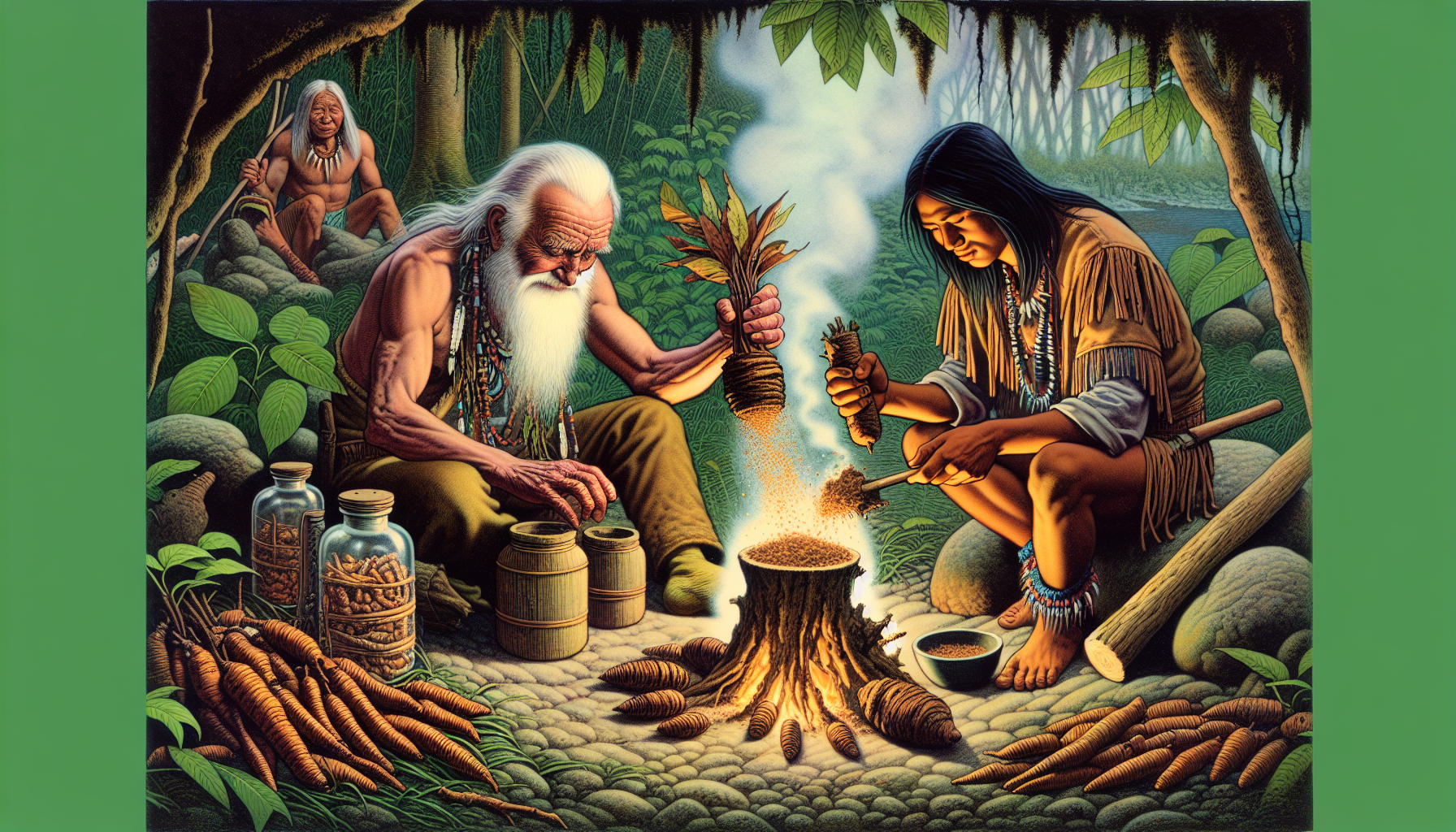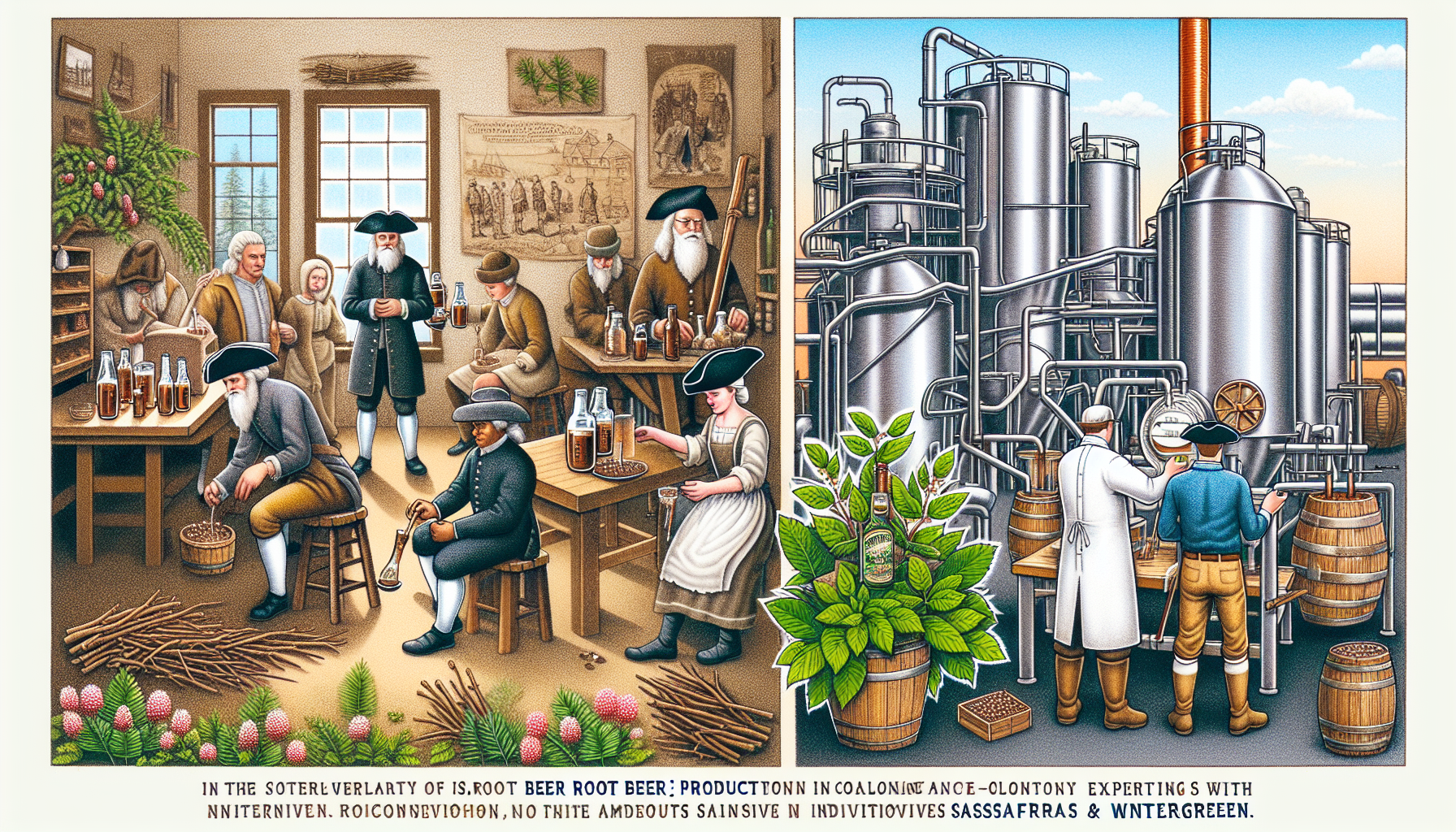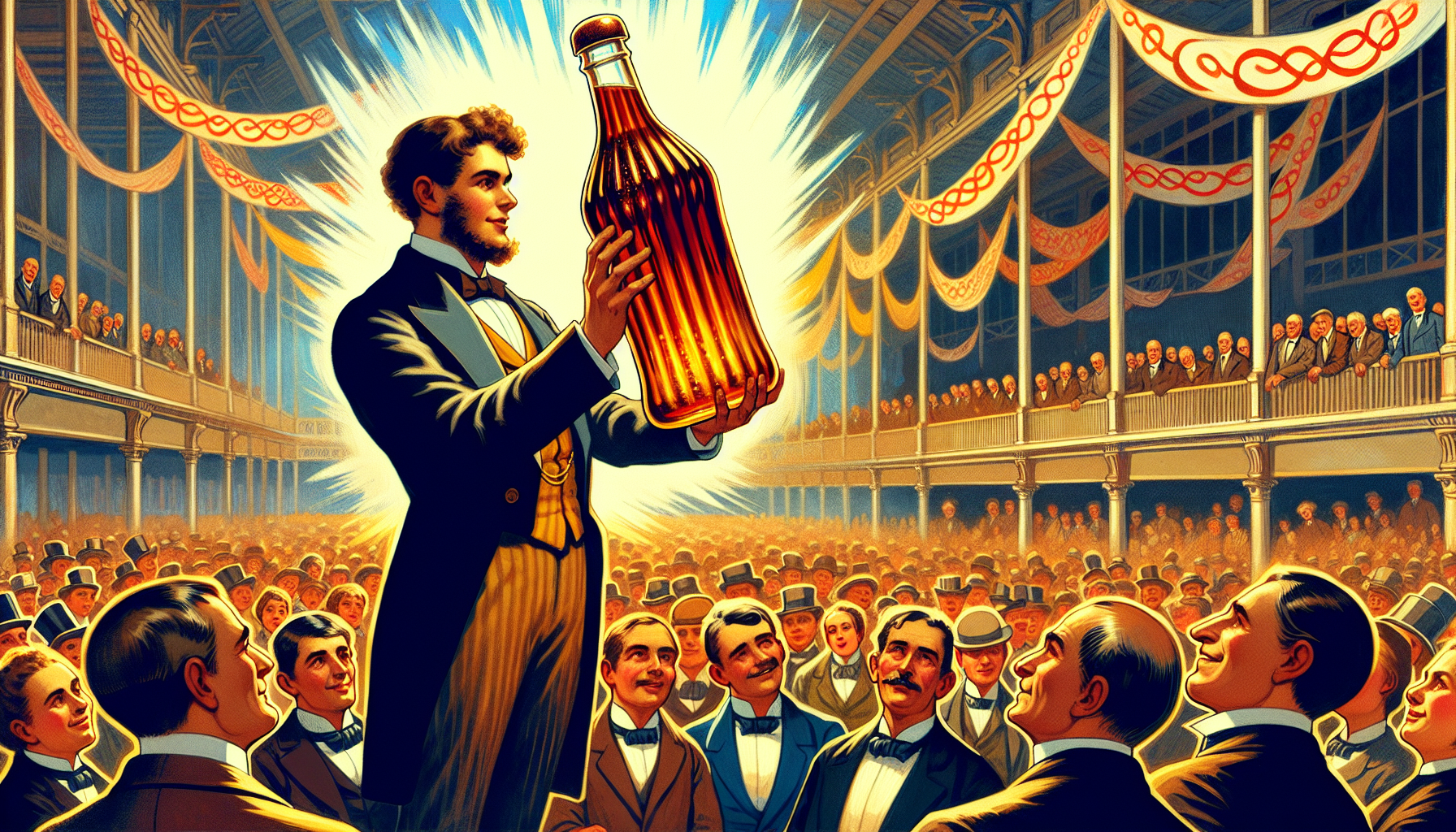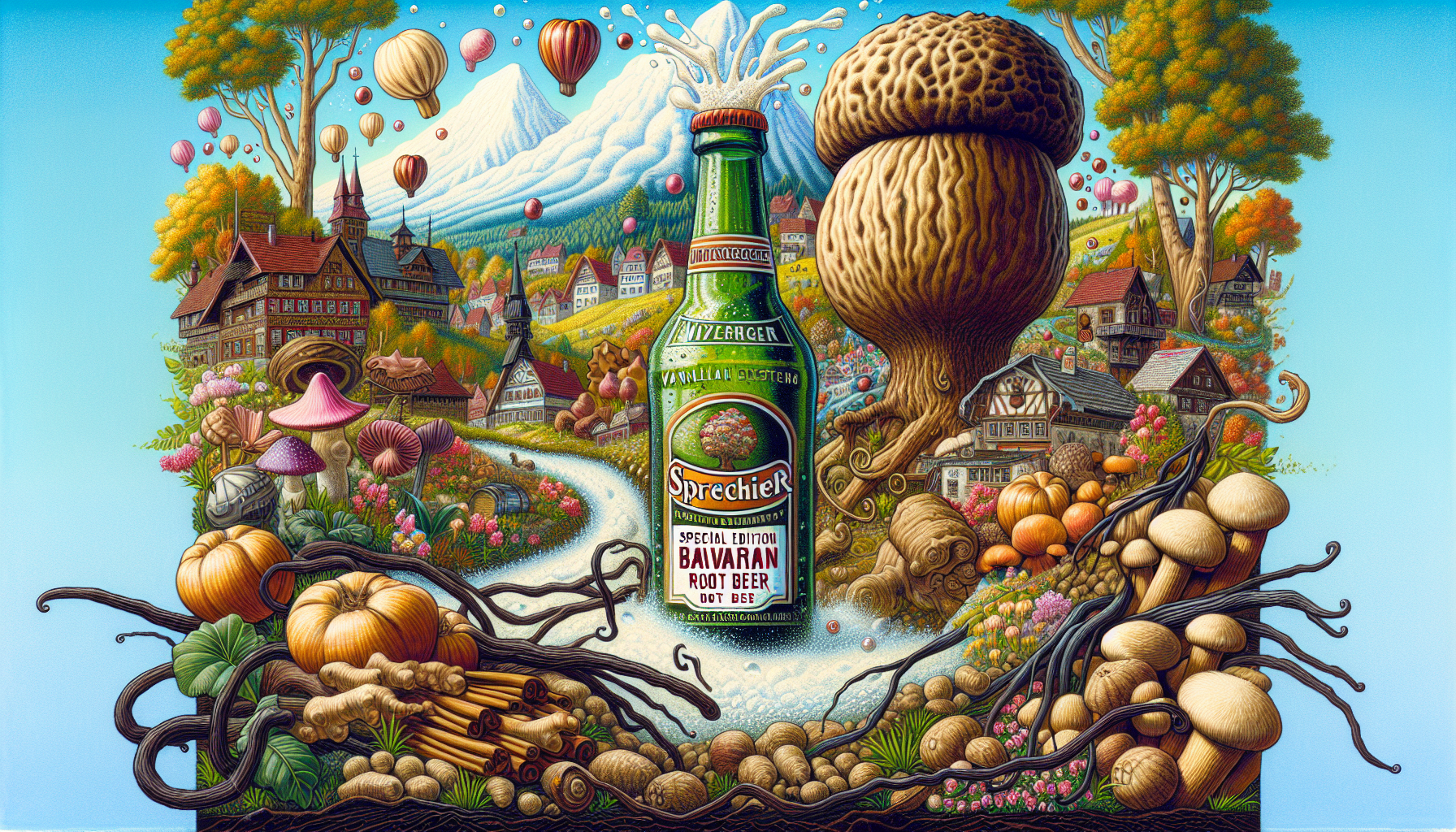Root beer’s journey from an indigenous brew to a commercial favorite is a tale woven into America’s fabric. This article offers a no-nonsense exploration into the history of root beer, revealing its earliest uses, cultural impact, and evolution into the fizzy soft drink enjoyed today. Gear up to trace root beer’s flavorful past and understand how it became synonymous with American tradition.
Key Takeaways
- Root beer’s origin traces back to indigenous North Americans who made medicinal teas from sassafras and sarsaparilla, eventually becoming a popular carbonated beverage.
- Charles E. Hires significantly influenced root beer’s commercialization, marketing his root beer at the Philadelphia Centennial Exhibition, and the Prohibition era boosted the drink’s non-alcoholic appeal.
- Today’s root beer landscape includes a wide variety of brands and flavors, with a growing craft root beer movement that experiments with traditional brewing methods and innovative ingredients.
Root Beer's Indigenous Beginnings

Long before the advent of soda fountains and commercial brewers, root beer had humble beginnings with the indigenous tribes of North America. Its history is steeped in tradition, deeply intertwined with the cultural and historical fabric of the country. The secret to its distinctive flavor? A blend of herbs, roots, and spices, brewed to perfection, forming a diverse range of taste experiences that vary by region.
What started as a medicinal concoction transformed into a beloved beverage over centuries. Indigenous tribes brewed root beverages that resembled tea more than the carbonated soft drinks that define modern root beer. The key ingredients? The root bark of the sassafras tree or the vine of Smilax ornata, also known as sarsaparilla, often combined with other ingredients like wintergreen and birch bark.
Sassafras and Sarsaparilla
Sassafras and sarsaparilla root weren’t just used for brewing a delicious root beer. Indigenous peoples utilized these plant roots for a variety of medicinal purposes. Some of the uses include:
- Sassafras was used to treat blood impurities, skin diseases, rheumatism, and more.
- Sarsaparilla could alleviate nausea and fevers.
- Sassafras poultices were used to heal wounds and sores.
- A decoction of sassafras root bark was a remedy for diarrhea and colds.
Both plants were recognized for their immune-boosting abilities, inflammation reduction, and allergy combatting properties.
European settlers in America quickly recognized the unique flavors and medicinal benefits of these plants and incorporated them into their culinary practices. The flavors of sassafras and sarsaparilla became so popular that these ‘new world’ ingredients were exported back to Europe.
Early Root Beverages
The indigenous tribes and European settlers brewed a warm beverage from sassafras called ‘saloop’, often served with milk and sugar. Aside from its medicinal use, dried sassafras leaves were used as filé powder to thicken and flavor dishes such as gumbo, highlighting its culinary significance.
However, it was the infusion of sassafras root flavor that led to the birth of what we now know as root beer. Initially considered a niche health drink, root beer gained popularity during the 18th century in the United States.
Thus, began the journey of root beer, evolving from a warm, medicinal beverage to a refreshing, carbonated drink loved by many, including the classic root beer float. This transformation is a fascinating part of the history of root beer.
The Evolution of Root Beer in Colonial America

As European settlers made America their home, they adapted their traditions to the new land. Root beer’s production evolved from European small beer traditions, adapting to the context of colonial America. These beverages, often referred to as ‘small beers’, were low in alcohol content, making them suitable for safe consumption throughout the day.
George Washington’s personal recipe for small beer, which used molasses for sweetness, reflects the simplicity and adaptability of recipes during colonial times. Root beer was not just a drink; it was a way of life, providing safe hydration and dietary benefits. In a way, root beer was the colonial version of today’s energy drinks!
Small Beers and Their Role
In colonial times, small beers were a safer alternative to water, offering nutritional benefits and preventing the risks associated with drinking potentially contaminated water. These low-alcohol beverages were readily available and consumed by everyone – troops, servants, enslaved people, and even children. Yes, you read that right! They were an affordable and accessible drink for all levels of society.
Root beer emerged from the tradition of small beers, providing sustenance for colonial workers throughout their day. The alcohol content in root beer typically did not exceed 2%, aligning it with the characteristics of traditional small beers.
Creating Root Beer
To create root beer, colonists brewed a combination of sassafras, sarsaparilla, and other local plants. This resulted in a beverage that was not just hydrating but also beneficial for health. A typical root beer recipe included ingredients such as:
- allspice
- birch bark
- coriander
- juniper
- ginger
- wintergreen
- hops
- burdock root
- dandelion root
All of these ingredients contributed to the unique flavor profile of the beverage.
Root beer evolved as a variation of small beers in colonial times, enjoyed for its safety as a hydrating drink and for its dietary benefits. The delightful mix of herbs, roots, and spices, including the root beer plant, created a unique flavor that captured the hearts and taste buds of people across the colonies. Today, root beer syrup is used to recreate this nostalgic beverage at home.
Charles E. Hires and the Commercialization of Root Beer

Enter Charles E. Hires, a young pharmacist with a keen interest in brewing. Hires started his career by saving money to open his own store in Philadelphia, auditing lectures at the Philadelphia College of Pharmacy to improve his knowledge. He discovered the recipe for a delicious tea and adjusted it for commercial production, initially offering it in a powdered form.
Hires presented his root beer at the 1876 Philadelphia Centennial Exhibition, which significantly contributed to its promotion. Building upon his success, Hires expanded his business interests into the wholesale of vanilla beans and authored a book on vanilla, demonstrating his versatility and expertise in various fields. Hires’ root beer eventually achieved widespread popularity with the help of promotional support from a newspaper editor, securing its position as the first successfully marketed bottled root beer.
The Birth of Hires Root Beer
In the late 19th century, Charles E. Hires developed a version of root beer in a shelf-stable powder form that could be easily transported and stored. This innovation made it possible to commercially produce root beer, making the beverage accessible to more people and playing a crucial role in the popularization of commercially produced root beer.
Fighting Prohibition and False Claims
Hires initially marketed his beverage as ‘powder root tea’ to local miners. However, he later changed the name to ‘root beer’ to make it more appealing to masculine preferences. This clever name change played a significant role in the beverage’s acceptance in a society where alcohol consumption was becoming a contentious issue.
The Rise of Modern Root Beer Brands

With the success of Hires’ root beer, more brands began to emerge onto the scene. A&W Root Beer, one of the oldest root beer brands, was founded in 1919 by Roy Allen and sold at five cents a mug. Barq’s root beer, another notable brand, appeared on the scene in 1898. A&W innovated the root beer experience by selling their product cold in frosted mugs, enhancing the drinker’s experience.
Other notable brands include:
- Dad’s Old Fashioned Root Beer, introduced in 1937, known for its creamy and spicy flavor
- Mug Root Beer, which started in 1940, became Pepsi’s root beer brand in 1986, replacing the On-Tap Draft Style brand
- Frostie Root Beer, established in 1939, was later acquired by Monarch Beverage Company, and then sold to Leading Edge Brands of Temple, Texas.
The Independent Breweries Company, known for IBC Root Beer, was founded in 1919. After changing hands multiple times, it is currently owned by Keurig Dr. Pepper. Stewart’s Root Beer, established in 1924, has cultivated an ‘ultra-premium’ soda brand image by selling sodas in glass bottles.
The Impact of Prohibition
The Prohibition era in the United States, when alcohol was banned, created a demand for non-alcoholic beverages. Non-alcoholic versions of root beer became commercially successful during Prohibition, offering a refreshing, fizzy alternative to alcoholic beverages.
The FDA Ban on Sassafras
Despite the popularity of root beer, the US Food and Drug Administration banned the use of sassafras in commercial root beer in 1960. The ban was implemented due to the presence of safrole, a component of sassafras oil, which was recognized as carcinogenic.
Traditional root beer recipes, which included sassafras oil, were outlawed as a result of the FDA’s safety concerns about the liver-damaging and carcinogenic effects of safrole.
Craft Root Beers and Their Unique Flavors

The rise of craft and artisanal beers has led to a resurgence in unique and innovative root beer recipes, as well as a renewed appreciation for traditional root beers. Craft root beers leverage innovative ingredients and flavor combinations, contributing to a rich array of flavors distinct from mass-produced brands offered by commercial root beer brewers.
Commander Ron's Root Beer, for example, offers a unique taste profile characterized by:
- the sweetness of cane sugar and molasses
- notes of wintergreen, sassafras root and sarsaparilla
- vanilla
- a hint of cinnamon
The authentic flavor of craft root beers like Commander Ron's is significantly influenced by its focus on all-natural ingredients that pay homage to the root beers of Colonial America.
Commander Ron's Root Beer
Commander Ron's Root Beer is characterized by a rich medley of classic flavors like wintergreen, vanilla and molasses, but stands out with its hint of cinnamon finish. The flavor of Commander Ron's is described as unique and rich, reflecting the craft and care that goes into its production.
Making Your Own Root Beer at Home
If you’re a DIY enthusiast or simply love the idea of creating your own unique flavors, making homemade root beer is an exciting journey. The preparation of homemade root beer involves:
- Simmering herbs to create a syrup
- Cooking a mixture of molasses and water with root ingredients
- Steeping the mixture to extract flavors
- Straining the mixture before further use
After creating the syrup, the following steps are taken to make root beer:
- Yeast is added to the mixture to initiate fermentation, crucial for developing the beverage’s alcohol content and carbonation. However, investing in a small keg like a Torpedo mini keg will allow you to carbonate your root beer with CO2 within minutes. Additionally, using yeast can cause excess pressure in bottles that may cause them to burst or erupt in a foamy cascade. Use caution and bottle at your own risk if using yeast.
- Following fermentation or carbonation, the root beer is bottled, allowing carbonation to build up, creating the fizzy texture common to the drink.
-
The bottled root beer is then refrigerated to halt yeast activity, if you decide to go this route.
Ingredients and Equipment
To embark on your homemade root beer adventure, you’ll need some basic brewing equipment. This includes:
- A brew pot
- Bottles for fermenting
- A funnel
- A ladle
- If using glass bottles, a bottle capper
It’s crucial to sanitize the brewing equipment to prevent contamination from bacteria, which can result in off-tastes or spoil the root beer.
Fermentation and Carbonation
The magic of homemade root beer lies in the fermentation process. Fermentation is initiated by adding yeast to the mixture and allowing it to ferment at room temperature, a process that typically spans 36 to 72 hours. Natural carbonation in homemade root beer occurs as yeast consumes sugars, producing carbon dioxide gas during fermentation.
The carbonation process is completed when the fermented root beer is bottled and capped, making a fizzy beverage as the yeast further converts residual sugars into carbon dioxide. To avoid bottle explosions from over-carbonation, it is vital to leave sufficient headroom in the bottle and refrigerate the bottles shortly after achieving the desired carbonation level.
Summary
From its indigenous beginnings to the rise of craft breweries, root beer has journeyed through time, adapting to the changing tastes and preferences of society. It has evolved from a medicinal beverage to a popular soft drink, with a rich tapestry of flavors and varieties. Whether you’re sipping a frothy mug of commercially produced root beer or enjoying a homemade brew, each sip is a testament to a rich and frothy past.
Frequently Asked Questions
Did commercial root beer come before Coke?
Yes, root beer came before Coke. Root beer was created in 1876, while Coca-Cola was introduced to the market in 1886, a year after Dr Pepper. So, root beer predates Coke.
What is the origin of root beer?
Root beer was first commercially marketed by a pharmacist named Charles Hires at the Philadelphia Centennial Exhibition in 1876 after he discovered a recipe for an herbal tea on his honeymoon.
What were the original ingredients used in root beer?
The original ingredients used in root beer were the root bark of the sassafras tree or the vine of Smilax ornata, also known as sarsaparilla, often combined with other ingredients like wintergreen and birch bark. These natural components gave root beer its distinctive flavor.
How did root beer evolve in colonial America?
Root beer evolved from European small beer traditions in the context of colonial America, with low alcohol content making it suitable for safe consumption throughout the day. So, it became a popular beverage during that time.
Who was Charles E. Hires?
Charles E. Hires was a young pharmacist who developed and marketed the first bottled root beer. He became well-known for his root beer recipe.

